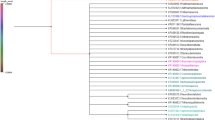Abstract
Twenty-four isolates of Tunga were collected from afflicted humans, dogs, cats, pigs and rats in Brazil. To investigate genetic diversity, a hypervariable section of mitochondrial 16S rDNA was amplified using PCR and subsequently sequenced. In order to compare results with another species of the genus Tunga, three isolates of the recently described Tunga trimamillata were also checked. Whereas eleven isolates (five from cats, three from dogs and three from humans) were of identical sequence, thirteen isolates collected from dogs, humans, pigs and rats showed differences in sequence up to 49%, so that the existence of one or more new species of Tunga may be presumed.





Similar content being viewed by others
References
Baldwin B, Sanderson MJ, Porter JM, Wojciechowski MF, Campbell CS, Donoghue MJ (1995) The ITS region of nuclear ribosomal DNA: a valuable source of evidence on angiosperm phylogeny. Ann Mo Bot Gard 82:247–277
Barnes AM, Radovsky FJ (1969) A new Tunga (Siphonaptera) from the nearctic region with description of all stages. J Med Entomol 6:19–36
Brothers WS, Heckmann RA (1980) Tungiasis in North America. Cutis 25:636–638
Essig A, Rinder H, Gothe R, Zahler M (1999) Genetic differentiation of mites of the genus Chorioptes (Acari: Psoroptidae). Exp Appl Acarol 23:309–318
Feldmeier H, Heukelbach J, Eisele M, Sousa AQ, Barbosa LM, Carvalho CB (2002) Bacterial superinfection in human tungiasis. Trop Med Int Health 7:559–564
Feldmeier H, Eisele M, Moura RCS, Heukelbach J (2003) Severe tungiasis in underprivileged communities: case series from Brazil. Emerg Infect Dis 9:949–955
Fiovaranti ML, Pampiglione S, Trentini M (2003) A second species of Tunga (Insecta, Siphonaptera) infecting man: Tungatrimamillata. Parasite 10(3):282–283
Greco JB, Sacramento E, Tavares-Neto J (2001) Chronic ulcers and myiasis as ports of entry for Clostridium tetani. Braz J Infect Dis 5:319–323
Heukelbach J, Oliveira FAS, Hesse G, Feldmeier H (2001) Tungiasis: a neglected health problem of poor communities. Trop Med Int Health 6:267–272
Heukelbach J, Wilcke T, Eisele M, Feldmeier H (2002) Ectopic localization of tungiasis. Am J Trop Med Hyg 67:214–216
Heukelbach J, Costa AML, Wilcke T, Mencke N, Feldmeier H (2004) The animal reservoir of Tunga penetrans in severely affected communities of north-east Brazil. Med Vet Entomol 18:329–335
Hopkins GHE, Rothschild M (1953) An illustrated catalogue of the Rothschild collection of fleas (Siphonaptera) in the British Museum (National History). Brit Mus Nat His 36–69
Kimura M (1980) A simple method for estimating evolutionary rates of base substitutions through comparative studies of nucleotide sequences. J Mol Evol 16:111–120
Kumar S, Tamura K, Jakobsen IB, Nei M (2001) MEGA2: molecular evolutionary genetics analysis software. Bioinformatics 17:1244–1245
Lewis RE (1972) Notes on the geographical distribution and host preferences in the order Siphonaptera. 1. Pulicidae. J Med Entomol 9:511–520
Marcilla A, Bargues MD, Abad-Franch F, Panzera F, Carcavallo RU, Noireau F, Galvao C, Jurberg J, Miles MA, Dujardin JP, Mas-Coma S (2002) Nuclear rDNA ITS-2 sequences reveal polyphyly of Panstrongylus species (Hemiptera: Reduviidae: Triatominae), vectors of Trypanosoma cruzi. Infect Genet Evol 1:225–235
Moore WS (1995) Inferring phylogenies from mtDNA variation: mitochondrial-gene trees versus nuclear-gene trees. Evolution 49:718–726
Moore WS (1997) Mitochondrial-gene trees versus nuclear-gene trees, a reply to Hoelzer. Evolution 51:627–629
Pampiglione S, Trentini M, Fioravanti ML, Onore G, Rivasi F (2002) A new species of Tunga (Insecta, Siphonaptera) in Ecuador. Parassitologia 44(Suppl 1):127
Pampiglione S, Trentini M, Fioravanti ML, Onore G, Rivasi F (2003) Additional description of a new species of Tunga (Siphonaptera) from Ecuador. Parasite 10:19–15
Parker A, Kornfield I (1996) An improved amplification and sequencing strategy for phylogenetic studies using the mitochondrial large subunit rRNA gene. Genome 39:793–797
Thompson JD, Gibson TJ, Plewniak F, Jeanmougin F, Higgins DG (1997) The ClustalX windows interface: flexible strategies for multiple sequence alignment aided by quality analysis tools. Nucleic Acids Res 24:4876–4882
Trentini M, Pampiglione S, Marini M, Gianetto S (2001) Observations about specimens of Tunga sp. (Siphonaptera, Tungidae) extracted from goats of Ecuador. Parassitologia 42(Suppl 1):65
Vobis M, D’Haese J, Mehlhorn H, Mencke N, Blagburn BL, Bond R, Denholm I, Dryden MW, Payne P, Rust MK, Schroeder I, Vaughn MB, Bledsoe B (2004) Molecular phylogeny of isolates of Ctenocephalides felis and related species based on analysis of ITS1, ITS2 and mitochondrial 16S rDNA sequences and random binding primers. Parasitol Res 94:219–226
Vobis M, D’Haese J, Mehlhorn H, Feldmeier H, Heukelbach J, Mencke N (2005) Phylogenetic relationship of isolates of Tunga penetrans from Brazil based on ITS1 and ITS2 sequences. Parasitol Res (in press)
Whitfield JB, Cameron SA (1998) Hierarchical analysis of variation in the mitochondrial 16S rRNA gene among Hymenoptera. Mol Biol Evol 15:1728–1743
Acknowledgements
We are grateful to Prof. Dr. Trentini from the University of Bologna for sending us three specimens of Tunga trimamillata to be used and included comparatively. J.Heukelbach was supported from a travel grant by the DAAD/CAPES PROBRAL academic exchange program.
Author information
Authors and Affiliations
Corresponding author
Rights and permissions
About this article
Cite this article
Vobis, M., D’Haese, J., Mehlhorn, H. et al. Molecular biological investigations of Brazilian Tunga sp. isolates from man, dogs, cats, pigs and rats. Parasitol Res 96, 107–112 (2005). https://doi.org/10.1007/s00436-005-1320-z
Received:
Accepted:
Published:
Issue Date:
DOI: https://doi.org/10.1007/s00436-005-1320-z




